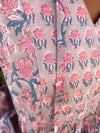
For millennia, India has been the birthplace of indigo, a mythical hue with roots in ancient history. Even before the arrival of Europeans, indigo was already being cultivated and used by Indian artisans, who had discovered the mysterious power of native plants to dye fabrics with vibrant, lasting colors. Once picked, fermented, and pulped, the indigo leaves create this royal blue that evokes both the depths of the oceans and the vastness of the sky.
This unique know-how, passed down from generation to generation, has made India one of the world's largest producers and exporters of indigo. Indigo-dyed fabrics, recognizable by their intensity and vibrancy, were once reserved for the nobility and ruling classes. They symbolized purity and protection, as indigo blue was considered a color that brought blessings.
The art of indigo dyeing is a complex ritual, where science and the magic of nature come together in an almost alchemical process. Unlike other dyes that color directly, indigo works invisibly. When the fabric is immersed in the dye bath, it emerges green, and it is upon contact with air, through oxidation, that the magic happens: the green gradually transforms into blue, as if the fabric were absorbing the sky itself.
Each step of the dyeing process is a subtle dance between water, air, and earth, where the artisan manipulates the fabric with expertise passed down for centuries. This skill requires patience and an intimate knowledge of the materials, as the hue can vary depending on the length of immersion, the temperature, or the number of baths. Artisans who master indigo are capable of creating infinite shades of blue, from the lightest and softest to the deepest and most intense.
Indian indigo is also a color of struggle and resilience. During the colonial era, indigo cultivation became a symbol of British oppression, as Indian farmers were forced to grow the crop at the expense of their own survival. But indigo, while a forced color, became a symbol of rebellion during the uprising against the colonial empire. In 1917, the Champaran Movement, led by Mahatma Gandhi, saw Indian farmers refuse to grow indigo for the British, marking a pivotal moment in India's struggle for independence.
Today, indigo is not only a reminder of this historical resistance, but also a symbol of renewal and sustainability. With the return to natural dyes and environmentally friendly artisanal practices, Indian indigo is experiencing a global renaissance. It embodies an ethical alternative to chemical dyes, offering a sustainable solution while preserving ancestral skills.




0 comments